2. Cultural Crossroads.
So what is France? How did it come to be? This class spans seven centuries and can only pick out parts of the story. We
shall see different entities form in Western Europe and then break up again. We shall see Frenchmen imposing their will
and religion on people at the other end of the Mediterranean, then turning on fellow-countrymen whose versions of the
French language, Christian faith, and poetic culture are only slightly different from their own. And in the midst of
all this, we shall see the creation of great cathedrals and the treasures within them that stand among the artistic
pinnacles of the medieval world.
Charlemagne, the first Holy Roman Emperor, united virtually the whole of Europe. His capital Aix-en-Chapelle (Aachen) became
the nexus of an international exchange of culture not seen since classical Rome. Two generations later, however, his
empire broke into three parts, the westernmost of which was called Francia. This was not yet the single country we know
today, but a number of regions with different rulers, different traditions, and in some cases different languages—a
cultural melting-pot.
In the second hour, we focus on the Duchy of Burgundy, created by the French King as a feudal dependency and eventually
reassumed into France. But in the meantime, it built up territories in the Low Countries and trade in the rest of Europe,
making it France's rival in both territory and wealth—and the greatest nursery for art and music outside Italy. rb.
The script, videos, and images will be posted immediately after class.
Q AND A
What is this section?
Whenever I get a question that I can't answer in class, I will look into it and post any further information here.
Why did Charlemagne's empire break up?
Peter mentioned a book that came out just last December, Oathbreakers: The War of Brothers That Shattered an Empire and Made Medieval Europe, by Matthew Gabriele and David M. Perry; you can get it on Amazon. He also mentioned the Battle of Fontenoy (841) between Charlemagne's three grandsons as the decisive event that led to the treaty that divided his kingdom between the three and set the shape of medieval Europe. You can read more about the Carolingian Civil War on Wikipedia.
What are the correct dates of the two Nativity scenes?
The dates on the handout and those on the slide are both wrong, but my general thesis was correct. The Portinari Altarpiece by Hugo van der Goes is dated around 1475, but it did not arrive in Florence until 1483. The Adoration of the Shepherds by Domenico Ghirlandaio is dated 1485, thus after the Hugo painting arrived. There is a very detailed article about the comparison in the Apollo Magazine; the site will try to get you to take out a subscription, but stick with it; you can read the article one time for free.
What happened to "That Italian Woman"?
I left out the planned section (D) on Christine de Pisan—an Italian making her career in France—for time, and because I had introduced her in another course. However, you can read what I would have said in the class script, and I strongly recommend the beautiful song set to her text by Gilles Binchois, which you will find listed below.
VIDEO LINKS
All the clips shown in class are available in some form, and many are longer than I had time to show. A few are
audio only, without the images I added to them. On the other hand, I uploaded all my own animated maps and titles
here, and added a couple of extra items. rb.
| |
|
|
|
|
|
| IMAGES |
The thumbnails below cover the slides shown in class, though
there may be a few small discrepancies. Click the thumbnail to see a larger image.
Click on the right
or left of the larger picture to go forward or back, or outside it to close. |
 | |
 | |
 | |
 | |
 | |
 | |
 | |
 | |
 | |
 | |
 | |
 | |
 | |
 | |
 | |
 | |
 | |
 | |
 | |
 | |
 | |
 | |
 | |
 | |
 | |
 | |
 | |
 | |
 | |
 | |
 | |
 | |
 | |
 | |
 | |
 | |
 | |
 | |
 | |
 | |
 | |
 | |
 | |
 | |
 | |
 | |
 | |
 | |
 | |
 | |
 | |
Here are brief bios of the artists, composers, and writers considered in the class, listed in order of birth.
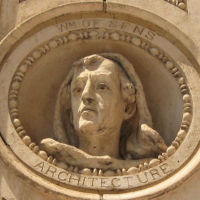 |
William of Sens , –1180. French architect.
William is thought to have been born in Sens, and was certainly involved in the building of the cathedral there. He was invited to England in 1174 to rebuild the east end of Canterbury Cathedral, which thus became the first example of Gothic architecture in England. He was injured by a fall from the scaffolding in 1177, and may have died in Canterbury.
|
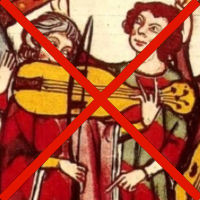 |
Berenguer de Palou, –1207. Catalan troubadour.
Although details are sketchy, it appears that Berenguer was born in Rousillon, straddling France and Spain. He was almost certainly a knight, and his 12 surviving cansos all deal with the theme of courtly love; 8 of them also have their original music.
|
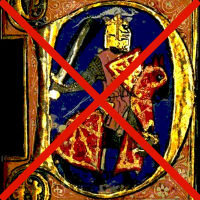 |
Theobald of Navarre, 1201–51. French troubadour.
Theobald was Count of Champagne from birth and King of Navarre from 1234. He initiated the Barons' Crusade, was famous as a trouvère, and was the first Frenchman to rule Navarre. [Wikipedia]
|
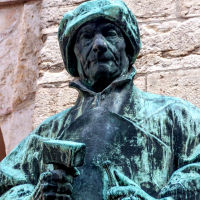 |
Claus Sluter, 1340–1405. Dutch sculptor.
Sluter was born in Haarlem, but joined the court of Philip the Bold of Burgundy in 1380 and remained there all his life. His most important works were monuments for the Duke: the gateway of the Chartreuse de Champmol outside Dijon, the Well of Moses in the cloister, and the mourning figures around the Duke's tomb.
|
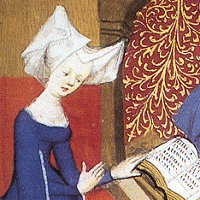 |
Christine de Pizan, 1364–1430. Italian-born French poet.
Born near Venice, Christine moved to Paris as a child, when her father became astrologer to the king. She married a court official, then had to support herself by her writing after he died. She wrote poetry and prose in most genres, and is credited as being the first female professional writer of modern times.
|
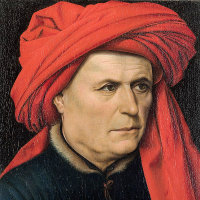 |
Robert Campin, 1375–1444. Netherlandish painter.
Campin has gradually emerged from scholarly shadows as the probable painter of a handful of works previously attributed to a conjectural "Master of Flémalle." In spite of the still-uncertain identification of many works associated with him, there is no doubt of his status as a key figure in the transition of Northern art from Gothic traditions to modernity. [The portrait here is by him, but probably not of him.]
|
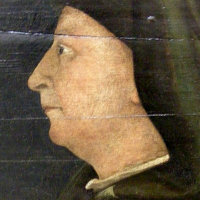 |
Filippo Brunelleschi, 1377–1446. Florentine architect.
One of the founding fathers of the Renaissance, he came to prominence as a sculptor in the competition for the Florence Baptistery doors, eventually won by Ghiberti. But it was as an architect that he made his biggest impression on the city, with the churches of San Lorenzo and Santo Spirito, and his crowning achievement, the dome of Florence Cathedral.
|
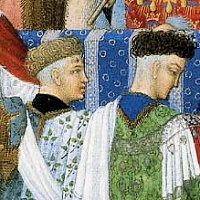 |
Limbourg Brothers (Herman, Paul, Johan), 1385–1416. Netherlandish manuscript illuminators.
Little is known of their earlier lives, but all three worked for Philip the Bold of Burgundy, and his brother Jean, Duc de Berry, for whom they produced the Très riches heures. [I have no reason to suppose that these are self-portraits, but we have no other!]
|
 |
Jan van Eyck, 1390–1441. Netherlandish painter.
The most celebrated and influential northern painter in the earlier 15th century, responsible for developing a style of oil painting capable of magnificent detail and effects of light. His major work, the altarpiece in Ghent Cathedral, is recorded to have been begun by his perhaps even greater brother Hubert. He was a renowned portraitist, including the enigmatic Arnolfini Marriage in London, and the supposed self-portrait seen here.
|
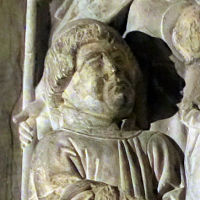 |
Guillaume Dufay, 1397–1474. Franco-Flemish composer.
Dufay (also spelled Du Fay and other variants) was born near Brussels. Writing in most genres and traveling widely, he was regarded as the leading composer of his time, composing for example a motet for the dedication of Brunelleschi's dome of Florence Cathedral. [The portait comes from his tomb.]
|
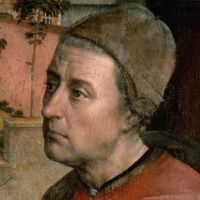 |
Rogier van der Weyden, 1399–1464. Netherlandish painter.
Very little is known of Rogier's life, except that he was highly successful in his time, with his works exported to Italy and Spain, and commissioned by princes both in the Netherlands and abroad. His extraordinary detail and emotionally intense compositions now place him firmly with Jan van Eyck and Robert Campin in the trinity of early Netherlandish masters. The image is a detail from his Saint Luke Drawing the Virgin, assumed to be a self-portrait.
|
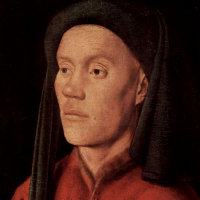 |
Gilles Binchois, 1400–60. Franco-Flemish composer.
Binchois was praised by his contemporaries in the same breath as Dufay, though his fame has declined somewhat. He is especially memorable as a melodist, with a gift for the long expressive line in both his secular and sacred vocal work. [He may or may not be the subject of this portrait by Jan van Eyck.]
|
 |
Johannes Ockeghem, 1430–1497. Franco-Flemish composer.
Writing both sacred and secular vocal music, he was one of the leading musicians of the late 15th century.
|
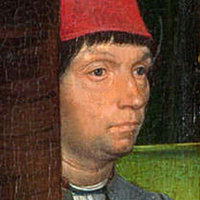 |
Hans Memling, 1430–94. Netherlandish painter.
Based in Bruges, and probably a pupil of Rogier van der Weyden, he developed a sweeter more balanced version of his style which brought him great success. Also spelled "Memlinc."
|
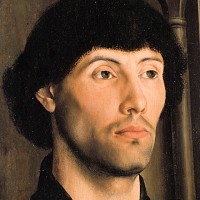 |
Hugo van der Goes, 1435–1482. Netherlandish painter.
The major figure of the second half of the 15th century in the Netherlands, he is known for his psychological observation and the richness of his backgrounds, as in the Portinari Altarpiece which introduced his style to Florence. [Identificaton of this as a self-portrait is conjectural.]
|
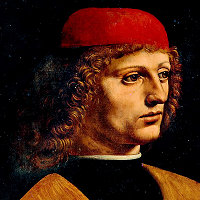 |
Josquin des Prez, 1440–1521. Franco-Flemish composer.
Josquin is considered one of the leading composers in the High Renaissance, and not just in the Franco-Flemish school. Almost all his works are vocal, mostly sacred. He is credited with breaking away from the tradition of long melismatic lines, writing instead in short imitative phrases that are closely expressive of the text. [This portrait of a musician by Leonardo da Vinci has not definitely been identified as Josquin, although both were in Milan at the same time.]
|
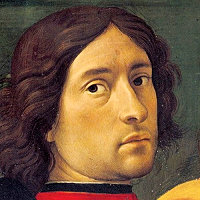 |
Domenico Ghirlandaio, 1449–94. Florentine painter.
In the same generation as Botticelli, Pollaiuolo, and Verrocchio, Ghirlandaio achieved success through his ability to execute large-scale subjects that often included portraits of his wealthy patrons. He was also a remarkably sensitive in his independent portraits, including the famous Old Man and his Grandson in the Louvre. Michelangelo was one of his pupils.
|
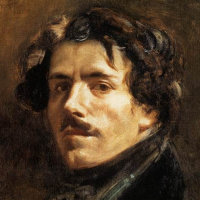 |
Eugène Delacroix, 1798–1863. French painter.
The leading French painter of the Romantic movement, he is known for his brilliant Rubensian color and his dramatic compositions. Especially in the first half of his career, these included political themes, such as The Massacre at Chios (1824) and Liberty Leading the People (1830), as well as subjects from Romantic literature. He also visited North Africa, and was constantly fascinated by the exotic.
|





































































